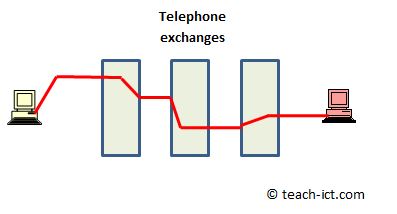2. Circuit switching
Circuit switching is an old method of ensuring that messages can be sent, intact, across a network.
Circuit switching dates back to the very first telephone networks, where switchboards were operated manually.

Between any two "nodes" (telephones or computers) there are long paths of wire through which the signal has to travel. Frequently there is so much physical wire that a signal may need to take multiple paths to reach its destination.
Circuit switching involves establishing this physical connection between the sender and receiver. Once the connection is made it ensures that, while in use, no other parties can use that path. Only when the message has been sent and received, is the circuit broken and the path made re-available for use by others.
Circuit switching can be used for transmitting digital data, but it has some serious limitations. It is inefficient to tie up entire cables or long series of channels just for a single message, especially when the network provider doesn't know how long the circuit will be in use.
On the other hand, with a direct, uninterrupted connection between sender and receiver, messages have minimal "latency". This means that the time between sending a message and receiving it is as small as possible.
Challenge see if you can find out one extra fact on this topic that we haven't already told you
Click on this link: What is circuit switching
